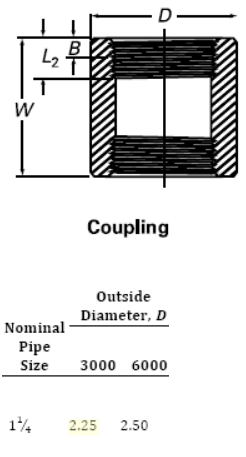285112, Township Road
270, Rockyview County, Alberta Canada
270, Rockyview County, Alberta Canada
This Code Case only applies to couplings attached by a single fillet weld.
Example of Figure UW-16.2 single fillet attachment:

Table UW-16.1 was introduced to VIII-1 in 2010 as a minimum fitting thickness when attaching fittings with a single fillet weld per Figure UW-16.2, and UW-16(f)(3)(-a), specifically (-a)(-6).
(-6) In lieu of the thickness requirements in UG-45, the minimum wall thickness for fittings shall not be less than that shown in Table UW-16.1 plus the thickness added for corrosion allowance.
However, Table UW-16.1’s minimum thicknesses are greater than some of B16.11’s 3000# coupling wall thicknesses. Code Case 3035 allows the use of standard 3000# couplings despite not meeting Table UW-16.1’s requirements.
Using a 1.25” 3000#, NPT coupling as an example:
B16.11, Table I-5 gives the OD of a 1.25”, 3000# coupling as 2.25”, and references Table I-2 for the wall thickness, however it does not specify whether you take the bore diameter or the socket wall thickness to determine the threaded couplings minimum wall thickness.
Table I-5
Table I-2
There are 3 possible ways to determine the wall thickness, 2 ways from B16.11, and using the OD of 1.25” pipe (1.66”) as the ID of the threaded coupling.
Where OD of the coupling is 2.25” according to B16.11
B16.11 Socket wall thickness:
TSock = 0.208” (Tabel I-2)
B16.11 Bore Dia. (1.675”):
This is the method Compress (Codeware Software) uses.
Tbore = (2.25-1.675)/2
Tbore = 0.2875”
OD of pipe (1.66”):
Tpipe = (2.25-1.66)/2
Tpipe = 0.295”
In Table UW-16.1, the minimum wall thickness for a 1.25” fitting that is attached by a single fillet weld is 0.30”, which is greater than all the wall thicknesses that were calculated above.
This brings up a few questions:
Get a variety of services to help you design a cost effective and ASME/CRN compliant product. We can help determine the best way to meet your needs.
We are a Canadian design and drafting company that provides services to fabrication shops and Engineering firms globally for ASME pressure-retaining devices and equipment.